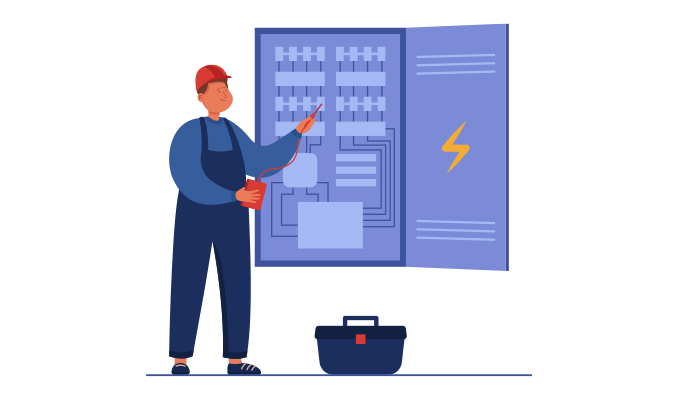Temporary power is essential for construction site operations, so it is important to know where to start. Construction site power varies from one project to another, with some projects requiring far more energy than others. So, no two temporary power setups will be the same. However, adding temporary power on-site usually follows a few core steps.
1. Making a Plan
Before any work starts on-site or any temporary power equipment is purchased, it is crucial to do comprehensive planning. This will involve the construction team leaders, project managers, the project owner, and potentially also a third-party consultant or electrician. On many construction projects, temporary power installation is contracted out to a dedicated power specialist, so if this is the case, representatives from that company will be integral to the planning process.
This stage is where a thorough site analysis is conducted to check for any potential electrical problems or hazards. Jim Whiteaker, a preconstruction supervisor, commented on temporary power planning in an interview with Electrical Contractor magazine. “We base a plan on our past experience, size of the project, owner’s requirement, and what type of equipment that will need temporary power. We do layouts based on this information,” Whitaeker explains. “Unknown loads of equipment from the owner and general contractor are also required, or we make our best estimate for these loads”.
In the planning phase, it’s crucial to make sure that all of these details are laid out and accounted for. Project owners and managers may have specific ideas or requirements in mind for any electricity used on site. For example, more and more people are prioritizing clean and carbon-neutral energy across countless industries. If project owners are trying to meet specific ESG goals, they may want a certain type of power infrastructure to be used in the construction site power system.
A carefully-executed temporary power planning phase will ensure that the next step, creating a site layout, will go smoothly.
2. Creating a Temporary Power Design
After constructing an initial temporary power plan, the next stage is designing a detailed layout for how all of the electrical components will be organized on-site. This tends to be the most variable stage from one project to the next. On projects where temporary power is being outsourced, a consultant or engineer from the power company will come and tour the construction site to help design the power layout.
During the site inspection, the temporary power planning team should make sure to take account of the existing utility sources around the site. The arrangement of power infrastructure around the site will depend on where any utility sources are located, where any potential hazard spots are, and the distribution of power needs around the site.
It is at this stage that power equipment is finalized and budgeted, including everything from generators to cables. Some projects may use a temporary power distribution box when mobility and portability are needed, such as on large or remote worksites. The project’s power expert will determine the voltage needed for the project and use that information to select the right size and type of generator.
When determining the placement of generators and other large power equipment, it is crucial to keep electrical safety standards in mind. Generators should be located in an area that won’t be near any traffic around the site. If severe weather is a concern, some kind of shelter or protection around generators may be necessary.
Before moving on to installation, construction teams also need to remember to take care of any necessary paperwork. In some cases, local cities or municipalities may require permits for temporary power installations.
3. Installing Construction Site Power Equipment
Once a detailed temporary power strategy and layout have been established, it is finally time for installation. The project leaders will schedule the best date for temporary power installation based around the overall timeline of the project. Part of this schedule is a plan for when the project will transition from temporary to permanent power down the road as well as a plan for the removal of all the temporary electrical equipment.
For the installation stage, it is crucial to have knowledgeable electrical experts on-site. Electrocution is one of OSHA’s “fatal four” most common safety hazards in construction. So, taking the proper electrical safety precautions is critical for success.
4. Inspecting and Maintaining Temporary Power
After the temporary power system is installed and set up, it needs to be professionally inspected. As mentioned above, local permits will likely be required. Those same authorities need to inspect the construction site power setup before construction crews can start using it. This step is necessary to make sure that all of the electrical equipment is up to standards and everything was installed correctly. If the temporary power system draws off any utility sources, the utility company will also need to come in and make the final meter connections.
After a successful inspection, the temporary power system will be ready to go. From there on out, it is the project team’s responsibility to make sure that everything is maintained safely throughout the construction process. Regular electrical check-ups are a good idea for making sure that everything stays in good working order.
Wrapping Up a Temporary Power Project
Every construction project is eventually concluded, so sooner or later it will be time to remove the temporary power installation. At some point in the project timeline, power will be transitioned over to the permanent power infrastructure. Afterward, electrical experts will carefully remove all of the temporary power components around the site. From start to finish, adding temporary power on construction sites is all about strategic planning and safe electrical practices.
about the author
Emily Newton is an industrial writer who specializes in covering how technology is disrupting industrial sectors. She’s also the editor-in-chief of Revolutionized where she covers innovations in industry, construction and more.


